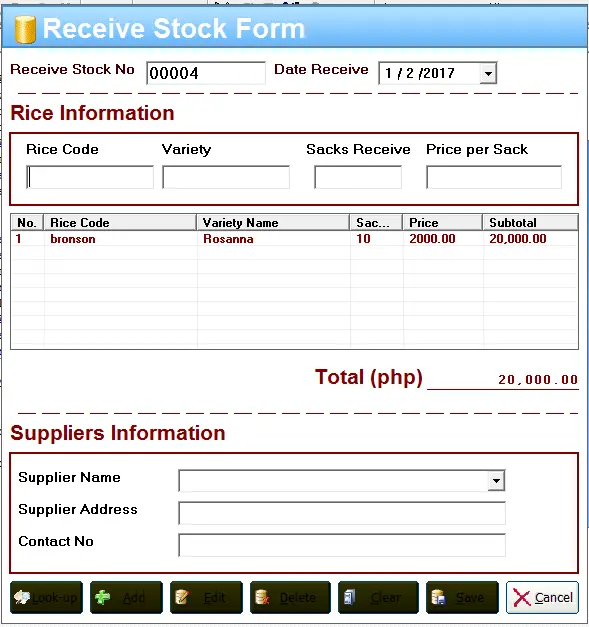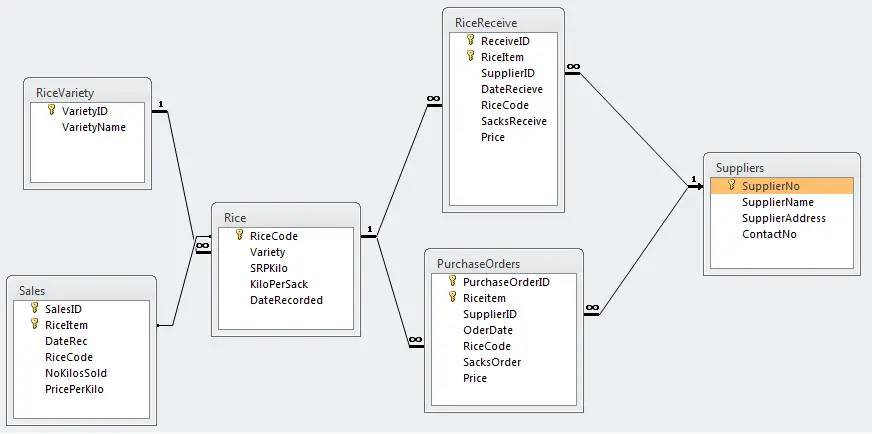Rice Sales and Inventory System
About the Project
Table of Contents
The researchers would like to help find solutions to the problem of Sales and Inventory system of store owners. Somehow this study would deepen the understanding of the researchers about marketing and sales inventory. The researchers would like to propose an automated inventory system that can provide reports of sales in a day accurately.
This system provides a convenient way for the accounting section and the administration to check and monitor the stocks. Automated inventory system is a broad concept that deals with the process of buying materials from supplier, storing it in a designated warehouse, and issuing it to the product or retail depending upon the nature of the business. Storable resources, such as raw materials, work-in process, finished goods, etc that are contained in a warehouse, and they are used to meet the demand of the existing and future customer of particular company. Store managers need to know the number of items in their storage shelves in order to place order or check any losses at any given period of time. These days, it is less likely to see companies using manual counting for their inventory management because it is so tedious and time taking.

Project Context
The system was called Sales and Inventory System. It serves as a significant application for store owners since it will record all the incoming and outgoing of products of the store.
Basic Features of Sales and Inventory System
- Records of stocks
- Statistical report of the system
- Manage branch, supplier and trucks information
- Monitor ordered items
- Verify delivered items
- Purchase delivered items
- Identify date manufactured and date expiration
- Disposal of products
Purpose and Description
The primary purpose of an inventory system is to keep accurate records of stock room supplies. A complete listing of the stock of raw materials and components, inventory system contains details or records of the products quantities and stock location of companies’ assets. They need to enhance their employees in the inventory keeping processes. Keeping track of inventory is vitally important for any successful retail enterprise. Inventory system let you know when it is time to stock-up an item that are running low and can also prevent you from the inventory system how the ability to keep on accurate record of the number of suppliers in the stock room. Also, it is convenient for the management to check the quality of the property, the location of the product, and the details of the product. It also controls the decision of the seller whether the stocks are still sufficient for the customers or not so that the management may suggest for “batch orders” among the patrons.
Objectives of the Study
General Objective
The objective of a system is to meet the demand of productivity by efficiently organizing the firm’s production on sale operations can minimize the firm’s investment in inventory, to avoid both over stock and under stock of inventory.
Specific Objective
- To be able to eliminate duplications in ordering and replenishing stocks.
- To be able to minimize loses through pilferage to ensure right quality goods at reasonable prices and design proper organization for inventory management facilitate furnishing of data for short-term and long-term planning and control of inventory.
- To be able to monitor properly the incoming and outgoing of stocks.
- To be able to cut back on overhead, waste and can help you to minimize theft (internal and external).

Scope and Limitation
It involves the processes which deals with the management of the inventory system such as purchase requisition, purchase order transaction, monitoring of incoming and outgoing of stocks. A paper-based inventory document was used in the analysis and design of the inventory system. All the property staff including the employee were involve in the various stages of development which are planning, analyzing, designing, and evaluation of the proposed system.
Features of the System
- Rice Inventory Management: The Rice Sales and Inventory System allows users to manage and track their rice inventory, including information such as rice type, price, and stock levels.
- Sales Management: The system allows users to manage and track rice sales, including information such as customer details, purchase order, and payment details.
- Order Processing: The system allows users to process rice orders, including creating purchase orders, tracking delivery status, and generating invoices.
- Stock Alerts: The system generates alerts when the rice stock reaches a certain level, allowing users to restock in a timely manner.
- Reports and Analytics: The system can generate various reports and analytics on rice sales and inventory, such as sales reports, inventory reports, and stock movement reports, which can be used to make informed business decisions.
- User Management: The system allows for user management, including creating user accounts, setting permissions, and monitoring user activities.
- Mobile Accessibility: The system can be accessed from mobile devices, allowing users to manage their inventory and sales from any location.
- Integration with other systems: The system can be integrated with other software systems, such as accounting systems, to share and exchange information.
- Security features: The system has security features such as encryption, multi-factor authentication, and audit trails to protect sensitive data and prevent unauthorized access.
- Scalability: The system can scale to handle large amounts of data and multiple users, making it suitable for rice businesses of any size.
FREE DOWNLOAD SOURCE CODE (template of the project is still on-going, bookmark the page for updates)
Summary
The researchers aim to help store owners find solutions for their Sales and Inventory systems. They propose an automated inventory system that can provide accurate reports of sales on a daily basis. This system allows for easy management and monitoring of stocks by the accounting and administrative departments. Automated inventory systems, such as this one, deal with the process of purchasing materials from suppliers, storing them in a designated warehouse, and distributing them to products or retail outlets. Such systems are useful for keeping track of inventory levels, identifying losses, and making informed business decisions.
Readers are also interested in:
Top 25 Ecommerce Project Ideas
Inventory Management System Conceptual Framework
Inventory Management System built with Core PHP
You may visit our Facebook page for more information, inquiries, and comments. Please subscribe also to our YouTube Channel to receive free capstone projects resources and computer programming tutorials.
Hire our team to do the project.

